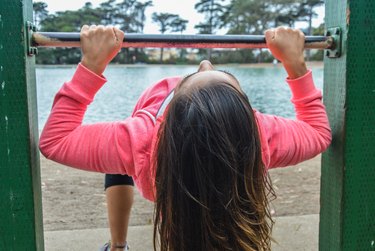
Inclined pullups, also called Australian pullups or inverted rows, are an excellent upper-body exercise: they work multiple muscle groups and simulate the sort of real-world movement you might make any time you pull yourself up or pull something down or across toward you. Although your back, shoulders and arms are the primary movers on this exercise, the sternal fibers of the pectoralis major, your largest chest muscle, do work to control the movement of your arm at the shoulder. Still, if you have to classify this exercise by muscle group to fit it into a workout split, call it a back exercise.
Inclined Pullup Description
Video of the Day
To do an inclined pullup, set the bar on a Smith machine to about waist height. Lie face-up beneath the bar. Reach up and grasp the bar in an overhand grip, hands slightly wider than shoulder-width apart. Squeeze your core muscles to keep your body straight like a board as you pull your chest up toward the bar. Extend your arms, lowering your body back to the starting position -- but don't lock your arms out or release the contraction in your shoulders. Repeat.
Video of the Day
Your body should pivot from your heels, which stay on the floor as you lift. If this is too difficult, either raise the bar or bend your knees, resting your feet flat on the floor. The closer you bring your feet to your body, the easier the exercise will be.
Muscular Misconceptions
Some exercisers get confused about which muscles are working during a given exercise because they feel the antagonist muscles -- the muscles opposite those performing the active contraction -- stretching. This popular misconception leads some to believe that inclined pullups are primarily a chest exercise; if you have little flexibility, you might feel your chest muscles stretching.
Primary Muscles Worked
The primary movers during an inclined pullup are your latissimus dorsi and trapezius muscles. Your rhomboids, posterior deltoids and the pulling muscles in your arms, including the brachialis and brachioradialis, activate too. You can shift your hands to an underhand grip for extra biceps involvement.
Chest Benefits of Inclined Pullups
Doing inclined pullups might actually make your chest look more attractive even though the chest muscles are only minimally involved because it strengthens your trapezius. Developing a stronger trapezius muscle can help reduce the forward slouch that is so common from tight muscles, often caused by sitting for long periods.
Complementary Exercises
You can further improve your posture, and thus the appearance of your chest, by pairing exercises like inclined pullups with shoulder and chest stretches to loosen those tight muscles.